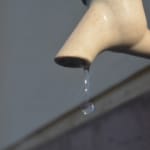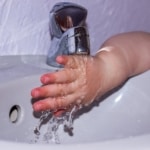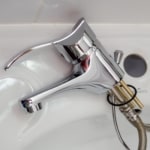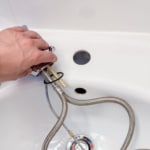Does Your Faucet Continue to Drip? (Causes & Simple Solutions)
You don’t expect any more water to be running after you turned off your faucet. Unfortunately, the reality is different in many households.
While a few drops after closing it can still be tolerated, a continued trickle over several minutes can drive up the water bill quite considerably.
In this article, we will tell you when continued dripping is normal and when it isn’t.
Regardless of whether you use a high or low pressure fitting – here you will find the right tips to solve this problem.
Contents
Why does a low-pressure fitting drip?
Since the problem of water continuing to drip occurs more frequently with this type of fitting, we should first clarify: What is a low-pressure fitting and how does it work?
Low-pressure fittings are characterized by the three hoses: Two of them lead to a hot water storage tank/boiler under the sink in the kitchen or bathroom. A third is connected to the water supply via the angle valve.
How exactly you differentiate a low-pressure fitting from a high-pressure fitting and what you absolutely have to pay attention to can be found in our separate article here.
Slight continued dripping is normal with low-pressure fittings
Unlike high-pressure fittings, low-pressure fittings draw only cold water from the water supply. So, if you set the fitting to “cold”, the water comes directly from the angle valve.
When you turn the lever to “warm”, the cold water flows into the boiler and there displaces warm water that flows into the faucet.
Even when the faucet is turned off, water still comes out of the fitting through a permanently open hose.
If the whole system were not open, pressure would rise in the boiler, which the boiler could not withstand in the long term. Hence the name “low-pressure fitting”.
Fortunately, if everything works properly, the amount of water that drips after closing the faucet is limited – especially if you use a metal rather than plastic boiler.
However, if the water continues to flow for several seconds, you should check the following causes:
1. Is the water pressure too high?
If more than a few drops appear after turning off the faucet, the water pressure for the hot water tank may be too high.
The first thing you should check is whether the so-called flow limiter has been forgotten.
This small but important component is located under the fitting between the angle valve and the cold water hose. If installed correctly, it will reduce the water pressure to 1 -1.3 gallons per minute.
If there is no flow restrictor, you should retrofit one. Otherwise the boiler can be damaged by excessive water pressure and in the worst case it can burst. At the latest when the expansion of the material is audible, it is time to act.
Fortunately, flow restrictors are relatively inexpensive. You only have to screw in the limiter between the angle valve and the hose. Of course, you should close the angle valve beforehand.
As an emergency solution until retrofitting, you can also regulate the water pressure by closing the angle valve a little bit (turning it clockwise).
If the valve is too tight, you can also turn the bell-shaped pressure reducing valve next to the main water valve. However, this will reduce the pressure in the entire household.
2. Is there air in the boiler?
Air inclusions in the boiler can also be responsible for water running out after the faucet has been turned off.
So, before you start the assembly, you should do the following: Shake the boiler a few times to let air out. Now comes the actual venting process:
- Turn the angle valve clockwise to shut off the water supply.
- Connect the hoses of the fitting to the boiler and the angle valve.
- Assemble the boiler, but do not connect it to the electricity yet.
- Open the angle valve and open the faucet. Turn the lever to cold until the water flows out without gurgling or splashing. Then do the same for hot water.
- Switch on the boiler and check how much water continues to run after turning off the faucet. Without any air pockets, it should only be a few drops.
3. Have the cold and hot water hoses been swapped?
After turning off the faucet, does hot water continue to flow even though you only turned on the cold water beforehand?
Then the faucet hoses were probably connected in the wrong way. In this case, an air bubble is created, which is responsible for the water that continues to run.
Proceed as follows to check:
- Turn off the angle valve and disconnect the boiler from the electric power.
- Unscrew all hoses from the boiler.
- Examine the three hoses of the fitting. To determine which hose is intended for which connection, blow into each hose once:
- The completely air-permeable hose belongs in the boiler outlet. Many boilers have this connection marked with a red arrow pointing upwards.
- The hose, which only lets air through when the cold water position on the faucet is open, must be connected to the angle valve.
- The third hose belongs to the boiler inlet. This is usually marked with a blue arrow pointing downwards.
Incidentally, incorrectly connected hoses are not harmful to the boiler. However, your water consumption will be significantly reduced as a correct installation stops the water from continuing to run.
Sustainable solution: the anti-drip function
As already mentioned, slight dripping is normal with low-pressure fittings. However, if you are bothered by it, e.g. because unsightly limescale stains appear, you should opt for a boiler with an anti-drip function.
In these models, a special reservoir is installed in the water tank that catches excess water and empties itself the next time the faucet is turned on. That saves a lot of water in the long run.
The disadvantage: retrofitting such a component is almost impossible. Boilers with this function are usually found in the premium segment, whereas the anti-drip function is very rare in cheap models under 100 USD.
Why is a high pressure fitting dripping?
In contrast to low-pressure fittings, a high-pressure fitting has only two hoses.
These are attached to the hot or cold water angle valve under the sink in the kitchen/bathroom. A hot water tank under the fitting is not necessary.
The other important difference: When the faucet is turned off, the fitting should be a closed system.
If a faucet drips even though it is turned off, then – unlike with low-pressure fittings – this is NOT desirable and indicates wear.
Most of the time, limescale is the culprit. Particularly in households with hard water, deposits form inside the fitting and make it leak. The following components are particularly susceptible to limescale:
1. Perlator
This small attachment at the end of the faucet is responsible for limiting the amount of water. However, if it is heavily calcified it can leak.
Here you can find out how you can easily clean your perlator (section “2. Clean the perlator”).
2. Valves
For two-handle fittings, valves with sealing rings are built into each of the handles to hold back the water. Over time, however, the sealing rings can become porous and leaky.
This article reveals how valves can be removed and replaced.
3. Valve seat
If the faucet still drips despite the new valve, a worn valve seat is also a possible culprit.
This is hollowed out by years of water flow, so that the valve no longer sits tightly. Fortunately, repairs are no problem even for laypeople.
You need a so-called valve seat cutter, which is available as a set with differently sized attachments.
Milling out goes as follows:
- Screw the appropriate attachment onto the milling tool and start screwing it into the valve seat.
- After a few turns (against clear resistance) inspect the valve seat: If dark threads and limescale can be seen, you have to re-mill – until the thread is bare.
- Slightly open the water supply to rinse out the chips that have arisen during milling. Let the water run for a while. No foreign bodies must remain in the valve seat, otherwise its tightness will be impaired.
- Now screw in the valve with the upper part and close it. Check to see if the faucet is still dripping.
Here you can see the described procedure clearly in the video:
4. Cartridge
Single-lever fittings have a plastic cartridge inside the faucet. Depending on the position of the lever, this lets through a certain amount of hot and cold water.
But here too, limescale tends to accumulate, causing leaks. Read here how you can remove deposits from the cartridge using simple means (section “3. Clean cartridge”).
Is the faucet running even though the main valve is turned off?
You would like to replace a faucet but cannot turn off the water using the angle valves? Maybe because they are too worn out? Then the only option left is the main shut-off valve.
This regulates the water supply for the whole house. But what a shock! Even though the faucet is turned off, water still comes out of the fitting. How can that be?
Since the main shut-off valve is hardly moved in many households, it is particularly prone to limescale and rust deposits. In the worst case, these ensure that the seals become porous and no longer hold back the water.
In this case, you should use a new valve. Before that is possible, however, you need to turn off the water.
There is another stopcock for this purpose – namely before of the water meter. The supplier is responsible for this. You are not allowed to change anything on the stopcock, but you can turn it off without hesitation.
Then check the so-called manometer or pressure gauge. If it no longer shows any pressure, the water is completely turned off and you can start the repair.
Change the valve of the main shut-off valve
Now it’s time to replace the valve:
- Use a wrench or pair of pliers to loosen the thread below the hand knob or handle.
Warning: do not use too much force to avoid damaging the pipe. If nothing moves at all, try using WD-40 rust remover or warming the valve. - Have a towel or a bucket handy to catch any remaining water from the pipe.
- Unscrew the valve and check the valve seat. Use your finger or a cloth to remove dirt residue.
- Before you screw in the new valve, you should seal the thread with Teflon tape or hemp fiber.
Sealing is of course not necessary with self-sealing valves. - You can now open the water again using the first stopcock.
The following video clearly shows how a main shut-off valve is replaced:
By the way: If the worst case occurs and the stopcock before the water meter is defective, all you can do is call your water supplier.
They must fix the defect. Fortunately, as a homeowner, you don’t pay anything for it.
Does the faucet suddenly start running?
If water runs out of the faucet as if by magic without opening it, good advice is expensive.
Some home owners even suspect paranormal reasons. In truth, however, this phenomenon can be explained with simple physics.
The material of the fitting expands when it is hot and contracts when it is cold.
If you wash your hands, for example, you turn the faucet on warm. The material then cools down.
Possibly the valve then moves in such a way that water suddenly flows through. Hence the ghostly dripping.
As is so often the case, the problem is probably due to the limescale – so it’s time to clean or replace the faucet so that the ghost stops.
The handle of the faucet opens by itself
Just as confusing is the following phenomenon: you turn off the handle of the faucet, but a short time later water comes out, as if someone had turned it on.
It is best to pay attention to how the handle behaves. It should be tight after you turned it off. If the stop feels too soft and the handle springs back after turning it, it is defective and you should replace it.
The problem can also be with the thread. By turning it for years, this can be worn off so much that the handle can be moved extremely easily.
If a pressure surge occurs in the line, the faucet is opened and water escapes.
If it is a bathroom or kitchen faucet, this problem only causes higher water costs.
The situation is different with free-standing faucets- for washing machines, for example. If water suddenly escapes there, it can flood the entire room.
Replacing the entire faucet is therefore highly recommended.
Sharing is caring 🙂 !
[addtoany]




